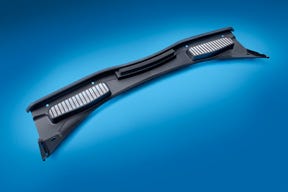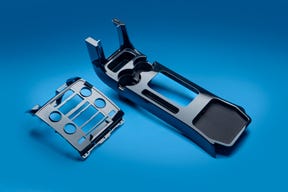Forty years of automotive ingenuity
Many things in the automotive industry have changed since the Society of Plastics Engineers first staged its Automotive Innovation Awards 40 years ago, but as the venerable program moves into its fourth decade, it’s clear that as a material, plastics will continue to help shape the industry in form, function, and ingenuity.
November 16, 2010
Many things in the automotive industry have changed since the Society of Plastics Engineers first staged its Automotive Innovation Awards 40 years ago, but as the venerable program moves into its fourth decade, it’s clear that as a material, plastics will continue to help shape the industry in form, function, and ingenuity.
Among this year’s nominees and winners, it was also evident that as the automotive industry turns down a greener road, plastics will ride along, helping OEMs cut weight from vehicles in response to more stringent fuel-efficiency standards, increasing end-of-life options for components and systems, and helping to eliminate paint and the VOCs they bring. Numerous industry firsts for plastics in auto were put forward as entries, ranging from individual components to systems to entirely new process technologies.
|
No. 1 with a projectile
On that final point, German Tier One supplier Röchling Automotive (Mannheim) showcased a cowl grille for Ford’s C-Max compact car that combined a hard polypropylene structure with a soft thermoplastic elastomer (TPE) seal into one part. The TPE portion, which creates a tight seal for the hood when closed, making for a quieter ride and reducing flutter, includes a channel running down its length with uniform wall thickness all around. The part took home the top prize in the body exterior category.
Replacing systems that use an extruded foam seal that requires additional assembly steps to join it to the cowl grille, the TPE seal’s most original feature is the integrated channel. Instead of using gas or water to hollow out the section, noting that these wouldn’t result in consistent walls, Röchling developed a patented process called projectile injection technology (PIT) whereby a winged polyamide projectile is shot through a partially filled cavity, propelled by inert gas at pressures ranging from 200-300 Bar. As a result, a hollow part with uniform walls is created.
The projectile, which looks like a pistol round with one large and two small fins running its length, is not recovered, but Röchling has created a system to recapture the melt that’s forced through the cavity to be fed back into a future shot. In the final part, the notches left by the ridges on the projectile reduce permanent deformation in the seal when the hood is closed. The channel runs 1500 mm long with an inner diameter of 16 mm and 2-mm-thick walls. Röchling used injection molding machinery supplier Engel (Schwertberg, Austria) as a press supplier for the process, which has patents covering the PIT sealing, recovery chamber, and winged projectile.
Door module opens doors for plastics
The plastic rear-door module for the 2011 Hyundai Sonata, which featured an integrated plastic rail for the window, was a tour de force of what plastics can offer automotive. Taking home the top prize in the chassis/hardware category, the module integrated 21 parts, cut assembly processes from five to one, and reduced weight compared with the 2009 steel version from 1.524 kg/door to 1.020 kg/door.
Much of the part consolidation and weight savings were derived from the integration of a plastic guide rail into the module. For the guide surface profile tolerance, maximum allowable warp was only 0.5 mm to ensure the window would open and close smoothly.
Using Sabic Innovative Plastics’ Stamax long-glass-fiber polypropylene resin, Hyundai and the material supplier ran around 50 Autodesk Moldflow simulations before settling on a counter rib to solidify the structure. The carrier would have to constrain the rear-window glass in the X, Y, and Z directions, as well as supporting it through 200,000 door-slam cycles, the so-called taxi-cab standard. The system also has to provide support to the glass lifter and pulley during an 80°C, 800-hour creep test at full glass-stall load.
Injection molded from Stamax 30YM240, the module’s mold employed sequential valve gating for its five gates to ensure a stable part. Ultimately, in addition to the window carrier, the plastic door module allowed Hyundai to also integrate wire harness clips, grab handle and trim attachments, drum cover and motor attachment, and the speaker base.
High gloss, no paint
In his presentation to the judging panel, Ford Motor’s H. Michael Sun said flatly, “Ford’s vision is to get rid of paint.” While that is obviously a long-term goal, the company presented an interim step, showcasing “A” gloss finish panels for the interior trim of the Ford Escape that have a piano-black appearance.
Winning in the process/assembly/enabling technology category, the components, which used Samsung PC/ABS molded into finished parts by Summit Polymers using tools from Namdo Tooling molds, include the door pull cup, console top finish, and the upper, center, and lower finish panels. The main panel, which houses the radio and CD player controls, has 12 holes, each providing myriad opportunities for flow marks and knitlines.
To eliminate any blemishes, the components’ tools had their cavity surface temperatures elevated by electrical heaters built into the mold, reaching from 105°C-180°C. Able to heat and control temperature by individual zones within the cavity depending on part geometry, the technology eliminates knitlines in the material, which was chosen for its scratch/mar resistance in a deep “jet black” color to match painted forerunners. Also, the use of electric heaters eliminates the need for water or oil as heat-exchange mediums, as well as their associated safety risks at elevated temperatures. The cycle time came in at 60 seconds, not much greater than the previous time.
By forgoing painting, Ford’s Sun estimates that the technology provided costs savings from 10%-49%, while eliminating or reducing volatile organic compound (VOC) emissions. Ford thinks the technology can be expanded to other surface-finish applications, car exteriors, and other industries. —Tony Deligio
About the Author(s)
You May Also Like





